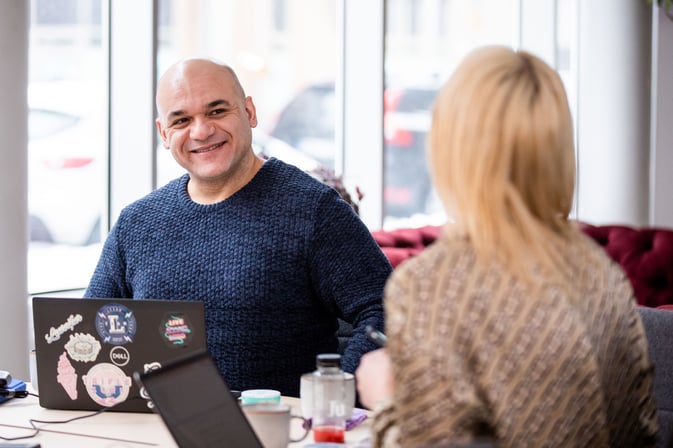A learning culture can be defined as a collective mindset where individuals actively share knowledge and experiences with one another. Playing a central role within the organization, a learning culture is a snowballing process where learning is not limited to personal gains but is shared to benefit others. We talked to Learnifier CEO Mattias Borg to find out more.
In today's dynamic environment, relying on an annual strategy-setting meeting is not sustainable. Learning must be a continuous process that keeps pace with reality. The individuals closest to the action possess valuable information, and their learning should align with ongoing developments.
Since everything is constantly changing, learning and disseminating new knowledge becomes essential. As long as Learnifier has existed, fostering a learning culture has been a natural part of the company’s progress. CEO and founder Mattias Borg wouldn’t have it any other way. Nor does he believe it would even be possible.
 Psst! Want to go even deeper on how to build a learning culture in your organization? Download our free guide, To create a learning culture – How we know we have one and how we can do even better
Psst! Want to go even deeper on how to build a learning culture in your organization? Download our free guide, To create a learning culture – How we know we have one and how we can do even better

Mattias Borg, Learnifiers' founder and CEO
– I honestly don't think there are any successful start-up or scale-up companies that don't have a learning culture. Failing and re-learning quickly is the whole structure. However, a learning culture may not come as natural to a company that’s been around a while and still relies on traditional hierarchies, Mattias says.
The recipe for success
An important aspect of fostering a learning culture is having ambition, direction, and goals. This means that learning is driven by a desire to achieve something. A motivation that sparks curiosity and provides a clear path for learning. To create effect, the overall company goals and direction must encompass individual, team, and organizational objectives. Basically, combining individual learning with organizational strategy is key to tailor a rewarding learning culture.
"A will to explore personal growth is the driving force. But good leadership is also super important to help people find their path."
– For instance, if a customer support member starts addressing an AI-related issue due to their passion, it contributes to the entire learning culture. While it may sometimes be challenging to determine what triggers curiosity and energy, it is crucial to be observant as such desires are truly exciting when they emerge.
Mattias is also convinced that individuals who possess an intrinsic desire to learn, even without a specific direction, play a vital role. Curiosity serves as the fundamental building block in this aspect.
– A will to explore personal growth is the driving force. But good leadership is also super important to help people find their path. Learnifier conducts quarterly growth talks, providing a platform for discussing how individuals want to develop within the company.
Further reading: Creating a learning strategy with real business impact – Featuring Anna Gullstrand from Mentimeter

An ongoing process
Establishing a learning culture is not enough – to make an actual difference it must be nourished continuously throughout the whole organization. One of the most common factors that hinders a learning culture is the inability to apply learned knowledge.
– Simply attending a course or training does not guarantee practical application, why a strong learning culture must be cultivated over time. It’s not done in a day – it should be done every day.
"Simply attending a course or training does not guarantee practical application, why a strong learning culture must be cultivated over time."
In Mattias’ opinion, there are several potential consequences for those not willing to invest whole-heartedly. Without a learning culture, teams may fail to interact effectively with the outside world, resulting in missed opportunities and a lack of growth. And organizations may miss out on the immense human potential that arises from curiosity.
– Of course, learning can still occur in a hierarchical structure where learning objectives are mainly pushed top-down, but the roles within it may become static while the market is constantly moving forward. It is the external world that demands or enables new ways of working, spreading throughout the organization, so keeping up is the only way forward. And when individuals are motivated and immersed in their pursuits, they tap into their full potential.
Further reading: 7 tips for effective measurement of learning initiatives

Sheer determination and foolish curiosity
While external motivators like salary, status, and career advancement will always exist, it is also inherent in human nature to seek personal development. Learning simply contributes to realizing oneself, and at Learnifier, focus lies on what everyone wants to achieve and where they aim to go. The company has several individuals who are entirely self-taught and excel in their respective fields due to their sheer determination.
"The important thing is that the internal drive to take a risk and do something unknown is present."
– The emphasis is on maximizing opportunities rather than minimizing risks. Even in the face of mistakes, we value learning by doing rather than blaming individuals. If you want a learning culture that benefits you in the long haul, this mindset is very important.
Mattias feels there should be an expectation for continuous learning and development in a good learning culture, but that doesn't necessarily require constant role changes.
– The important thing is that the internal drive to take a risk and do something unknown is present. I believe that foolish curiosity is at the core of entrepreneurship. At Learnifier, we embrace it fully, he concludes.

Psst! Want to know more about how to create successful learning experiences? We have summarized 30 tips in our guide: 30 tips to create engaging learning that gives results
Mattias Borg’s 3 musts when creating a learning culture
- The right mindset
Being a curious fool is good! You need a core of individuals with the attitude that anything is possible. - Potential at play
We all have potential inside– how to best release it is the million-dollar question. Start by exploring individual needs and wishes. - Tools that help facilitating the process
Create your structures and processes with the intention of facilitating forward drive, learning and curiosity. Invest in tools that make it possible to spread knowledge and learning with ease.
Learnifier is a learning platform used by hundreds of companies and organizations to quickly and easily share knowledge and create training. Since 2012, we have helped over 300 companies digitize and adjust their skills development for modern-day challenges.
.png?width=153&height=58&name=Learnifier%20TextLogo%20NearBlack%20-%20PNG%20MEDIUM%20-%20800px%20(2).png)






